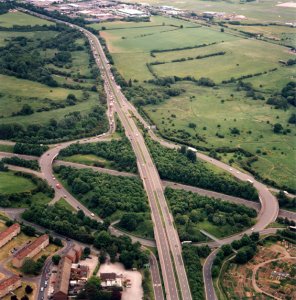A45/46 Tollbar End ImprovementInterim Client & Outline Design Award Client: Highways Agency |
... |
89.4% |
The Project
In June 2005 the Highways Agency as client appointed Morrison Construction, with Designer Hyder Consulting, on this Early Contractor Involvement (ECI) contract with Arup as the client’s representative. The project was one of the first required to follow the Highways Agency’s Project Control Framework (PCF).
The A45/A46 Tollbar End is a key strategic link on the trunk road network to the south of Coventry between Stivichall and Tollbar End junctions, adjacent to Coventry Airport. The junction facilitates traffic movements between the M40, M6, M1, M45 and M69 motorways and links Birmingham, Coventry, Leicester and London.
The improvements to this part of the Highways Agency network consist of reducing heavy congestion to the 70,000 vehicles per day which pass through the junction due to increasing traffic flows at these two strategic locations.
The overall length of the scheme is 3km. The A45 Stonebridge Highway is a dual two-lane carriageway, which is to be asymmetrically widened to dual three-lane carriageway. Tollbar End Junction will be improved by enlarging the roundabout and constructing a dual two-lane underpass to link A45 Stonebridge Highway to the A46 Coventry Eastern Bypass.
Associated improvements to adjacent roads and structures are also incorporated, including a new signalised junction between Siskin Drive and Rowley Road. The construction value of these works has been estimated at approximately £105 million.
The Highways Agency’s brief states that the design should integrate environmental mitigation measures, regular liaison with local community groups and ensure best practice is followed during and after construction.
Stivichall junction |
Project design
The location of the grade-separated junction below the flight path envelopes for Coventry Airport posed particular challenges. These have been overcome by using innovative approaches to both design and construction. The ECI contract, utilising the contractor’s practical experience of construction methods, led to designs being favoured that allowed for a realistic assessment of construction options below the flight path.
The existing pavement with a 20-year design life has been incorporated into the online widening design by assessing its residual life to determine the appropriate pavement rehabilitation and strengthening measures required.
The project has been designed to avoid any significant impacts on the environment. Other measures to reduce, as far as is possible, adverse environmental impacts include:
- Earth mounds and noise fences
- Low-noise road surfacing
- Lighting will be designed to current standards to minimise light spillage outside the road corridor
- Planting of trees, shrubs and hedges common to the location
- New habitats for wildlife
- Bio-retention tank to provide attenuation and pollution control
- Storm-water wetland areas.
|
Communication
Consultation has been undertaken at regular intervals throughout all project stages. The project has a Communications Plan which includes public information exhibitions, the Highways Agency Information Line (HAIL) to deal with queries, and regular ongoing public liaison meetings with residents and other interested parties. The project employed a Public Liaison Officer as a single point of contact for third parties.
Co-locating of Morrison Construction’s team in Hyder’s offices enabled close liaison between contractor and designer at each stage and encouraged the incorporation of buildability into the preliminary design, thus honing the target cost.
Extensive consultation with interested parties took place, resulting in little objection to the scheme to date. The scheme was classed as “urban” in May 2006 and the new PCF process was followed to the end of the Preliminary Design Stage and through to Statutory Procedures & Power Stage.
The draft Orders and the Environmental Statement were published in March 2009 with the public inquiry taking place in January and February 2010. The scheme awaits the Secretary of State’s decision.
Public Rights of Way
A particular challenge for the design team was balancing the need for major road improvements with the need to maintain pedestrian and cycle connectivity for local residents.
During construction, access for non-motorised users along all affected routes is to be maintained by measures such as traffic management, temporary diversions, management of user movements and signage for affected routes. Access to public transport facilities will also be maintained, with a temporary bus stop installed where necessary.
Once operational, the project will be accessible by pedestrians and cyclists. The project does not create any new footways, cycle routes or bridleways, but the realignments will help to eliminate crossings of the carriageway where there is currently no provision for pedestrian crossings.
Find out more about this project.



